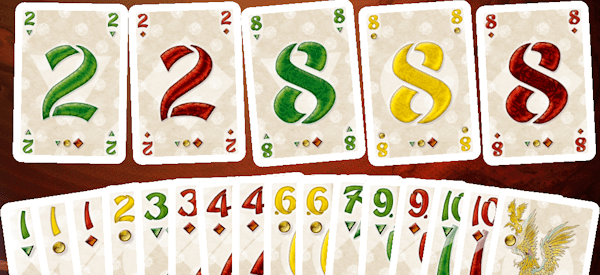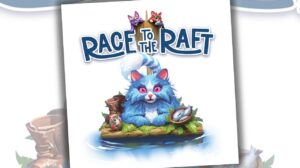A Brief History
Back when I was in the Navy, I became enamored with the game designer Richard Garfield. He had designed two games I enjoyed in those days: Magic: The Gathering and RoboRally. We had a blast playing these games… and one other game: The Great Dalmuti. When I was introduced to Gang of Four, it was described as a sort of hybrid of Dalmuti and Poker. And I think this is an accurate description.
- In Gang of Four you are dealt a hand of cards you are trying to get rid of (like in Dalmuti).
- The player who did most poorly in the previous hand had to exchange their best card with the person who did best in the previous hand (like in Dalmuti).
- The player that leads determines how many cards need to be used in a play for that round (like in Dalmuti).
- The hands are ranked exactly as they are in Poker.
This is where the similarities end, however.
A Very Cool Deck of Cards
Gang of Four is a game for four players. At the start of each hand, each player is dealt 16 cards. The object is to get rid of all of your cards and catch the remaining players with as many cards in their hand as you can.
The deck is made up of basic cards numbered 1 (the lowest ranking cards) to 10 in three suits: green (the lowest suit), yellow, and red (the highest suit). There are two of each suit in each rank (e.g., there are two green 5s, there are two yellow 7s, etc.). Thus, you have (10 ranks × 3 suits × 2 copies) 60 such cards.
Additionally, there are four special cards. These are:
- The Rainbow 1: There is a card with a rank of 1 that has all three suits. This card counts as a card of any suit. This card is also used to determine who opens the first round of play.
- The Phoenixes: There are two Phoenixes, one each in green and yellow. As far as ranking these cards, they are each above the 10s. As with other cards, the yellow Phoenix is considered higher than the green one.
- The Dragon: There is a red Dragon. This is the highest ranking card in the deck.
As indicated above, when a round begins, each player is dealt 16 of these cards. If this is round two or later, the player that was caught with the most cards in the previous round must give the player that went out their highest ranking card. Then, the player they gave that card to may give them any one card from their hand.
The round can then begin.

Playing Cards
If this is the first round of the game, the player that has the Rainbow 1 leads; they must play a hand that includes that Rainbow 1. If this is the second or subsequent round, the player that went out the previous hand leads; they may play any hand they desire to start. The lead player sets the tone for the round. They may play any of the following hands:
- A Single-Card: Any single-card may be played. The round that follows will be a series of single-card plays. Each player may play any card that is of a higher rank than the current card; or, if they have a card that is of the same rank but of a higher suit, they may play that. The Dragon can only be played as a single card and is the highest ranking single card in the game.
- A Pair: Any two cards of the same rank may be played (suit does not matter). The round that follows will be a series of pair plays. Each player may play any pair that is of a higher rank than the current pair; or, if they have a pair that by virtue of its suits would be higher than the current pair, they may play that. The phoenixes can be played as a pair and are the highest ranking pair in the game.
- A Three-of-a-Kind: Any three cards of the same rank may be played (suit does not matter). The round that follows will be a series of three-of-a-kind plays. Each player may play any three-of-a-kind that is of a higher rank than the current three-of-a-kind; or, if they have a three-of-a-kind that by virtue of its suits would be higher than the current three-of-a-kind, they may play that.
- A Five-Card Hand: Five card hands are broken down into four types (from lowest to highest): straight, flush, full-house, and straight-flush (just like in Poker). If a five-card hand is played, the round that follows will be a series of five-card hands. Each player may play any five-card hand that is of a higher rank than the current five-card hand; or, if they have a five-card hand that by virtue of its suits would be higher than the current five-card hand, they may play that.
- A straight is any five cards that are in sequence (e.g., 3, 4, 5, 6, 7) that are not all the same suit.
- A flush is any five cards that are not in sequence (e.g., 1, 4, 5, 7, 8) that are all the same suit. A flush is considered a higher hand than any straight. The phoenixes and the dragon cannot be played as part of flushes.
- A full-house is a three-of-a-kind and a pair. A full-house is considered a higher hand than any flush or straight. The phoenixes can be played as the pair in a full-house.
- A straight flush is any five cards that are in sequence (e.g., 6, 7, 8, 9, 10) and are all the same suit. A straight flush is considered a higher hand than any full-house, flush, or straight. The phoenixes and the dragon cannot be played as part of straight flushes.
- A Gang of Four: There is a special hand that can be played which trumps all other hand-types. This is the Gang of Four. Despite its name, Gang of Four is made up of four or more cards of the same rank (suit does not matter). What makes a gang of four special is that it can be played following anything that was played before it (e.g., if the round was led with a pair, any higher pair could follow that, as could a gang of four). Once a Gang of Four has been played, the round shifts from being whatever was led to a round in which only higher gangs of four can be played. The lead player can open with a gang of four.
Since a gang of four can be more than four cards, any gang of four that is made up of five cards is higher than one made up of four, and so on. This means that the highest hand in the game is a gang of four made up of seven 1s!
Completing a Round and Scoring
After the lead is made, players go in turn playing higher hands of the type led (or shifts the play to gangs of four), or they pass. Players must pass if they have no legal play; players may pass even if they have a legal play.
There is an odd exception to the normal play: if the player that follows you has only one card in hand, then you must play if you can.
- If you are leading, you must either play a hand that uses more than one card, or you must play the highest single card you have in your hand.
- If you are not leading and this is a single-card round, you must play the highest single card you have in your hand.
- If you are not leading and this is not a single card hand, you must play if you are able.
Play for any round continues until three players in a row pass, or a player plays their final card. If three players in a row pass, then the round ends and the player that did not pass leads for the next round. The moment any player plays their final card(s), leaving them with zero cards in hand, the round ends immediately and scoring begins.
The player who went out gets zero points. Since the game is scored like golf (low score wins), this is a good thing. Each other player gets points based on how many cards they were caught with.
- 1-7 cards: score 1 point per card left in your hand.
- 8-10 cards: score 2 points per card left in your hand (16 to 20 points).
- 11-13 cards: score 3 points per card left in your hand (33 to 39 points).
- 14-15 cards: score 4 points per card left in your hand (56 or 60 points).
- 16 cards: score 5 points per card left in your hand (80 points).
If any player has 100 or more points, the game is over. The player with the lowest score wins. Otherwise, deal the cards and play the next round. Note: the direction of play alternates each round (i.e., counter-clockwise, then clockwise, then counter-clockwise, etc.).
A Ray of Sunshine…
When you first get your hand and you sort out the cards, you immediately start thinking about the hands you can make. A straight here, a full house there; the limited number of suits create more opportunities to make flushes. And this is a joyous moment! None of the cards are on the table yet. There is a universe of possibilities.
Do you have the dragon? If so, this means you can grab the lead the moment a player is down to playing 1-card hands. Do you have both the phoenixes? Then there is no pair you cannot jump on and take control.
There are few things in card gaming that feel better than taking control of a round of Gang of Four where you have the cards to dominate and ensure that nobody is taking control back from you. That is unless you have the cards needed to take control from someone else. Someone who thought that had the dominant hand and was not counting on you playing six 1s to disrupt their plans.
Figuring out when it makes sense to play a triple you have as a pair to gain control—or when to let that pair slide so that you can keep the three-of-a-kind for a later play. All of these are great feelings! And while you are making these calculations, the game is a wonderful experience. Even if your plan falls short, you can laugh at the situation or play that disrupted things. Gang of Four can be a very fun game!
…Behind a Very Dark Cloud
Like I said, Gang of Four can be a very fun game. I have enjoyed it, but I think I am done with it. The biggest issue with the game is what I would consider a somewhat significant flaw: the scoring system and how the rounds are played make coming back from a game in which you are losing something you have no control over.

Allow me to explain. Suppose that you have been playing a game with three opponents; we will call them Buffalo, Rabbit, and Tiger (the names of the computer opponents in the Steam implementation). Over several rounds of play, you are doing well and have 11 points; Buffalo has 42 points, Rabbit has 9 points, and Tiger has 67 points. Then, you get a bad hand, or just have the ill-fortune of not being able to gain the lead in a round, and you are caught with 14 cards, scoring you a whopping 56 points, for a total of 67. Ouch! Buffalo was caught with 8 cards, scoring 16 points, for a total of 58 points, Rabbit went out, keeping them at 9 points, and Tiger had 6 cards in hand, scoring them 6 points, for a total of 73. Now obviously, you want to be careful, as you are potentially one hand away from going over 100 points. Unfortunately for you, so are Buffalo and Tiger!
There is nothing you can do to direct anything toward Rabbit and there is no way to reduce your score. Play well, and you will ensure you lose because you will force Buffalo and/or Tiger over the 100 point threshold, handing the game to Rabbit. Best I can tell, there is literally no strategy you can use that will allow you to win this game; it will come down to luck as you hope that Rabbit gets bad hands and ends up in the same boat as the rest of you.
Were it not for this one glaring aspect of the game, this would be a great game! As it is, it is merely a good one.










